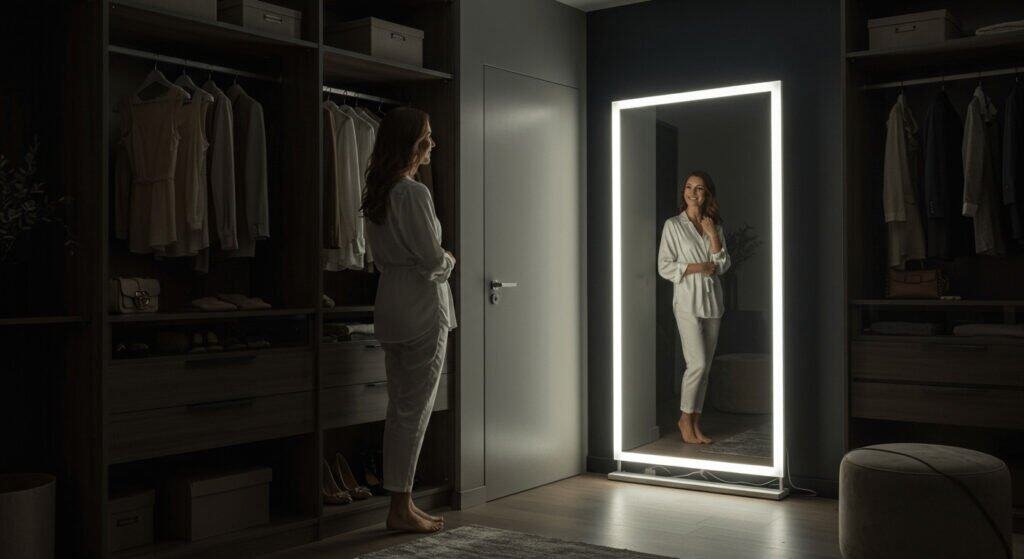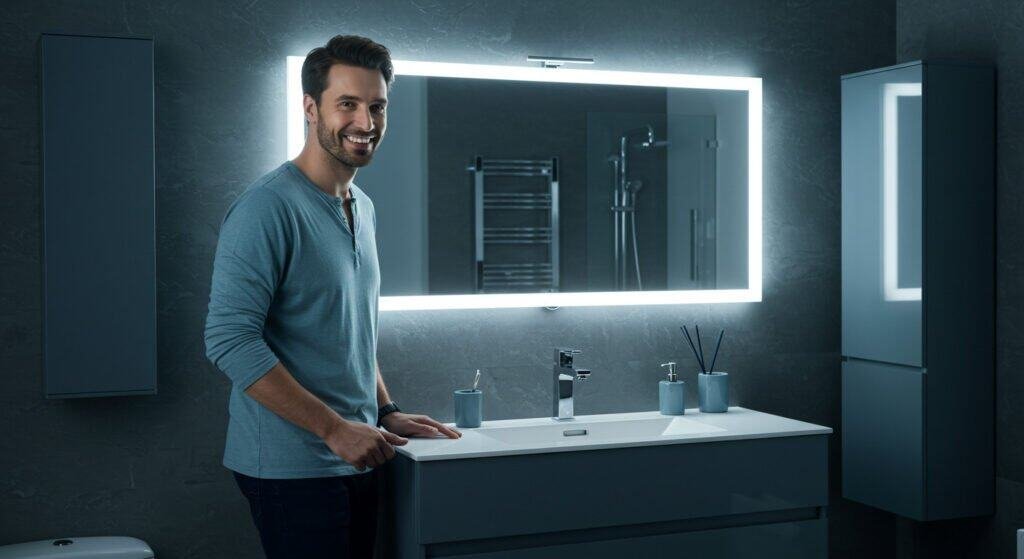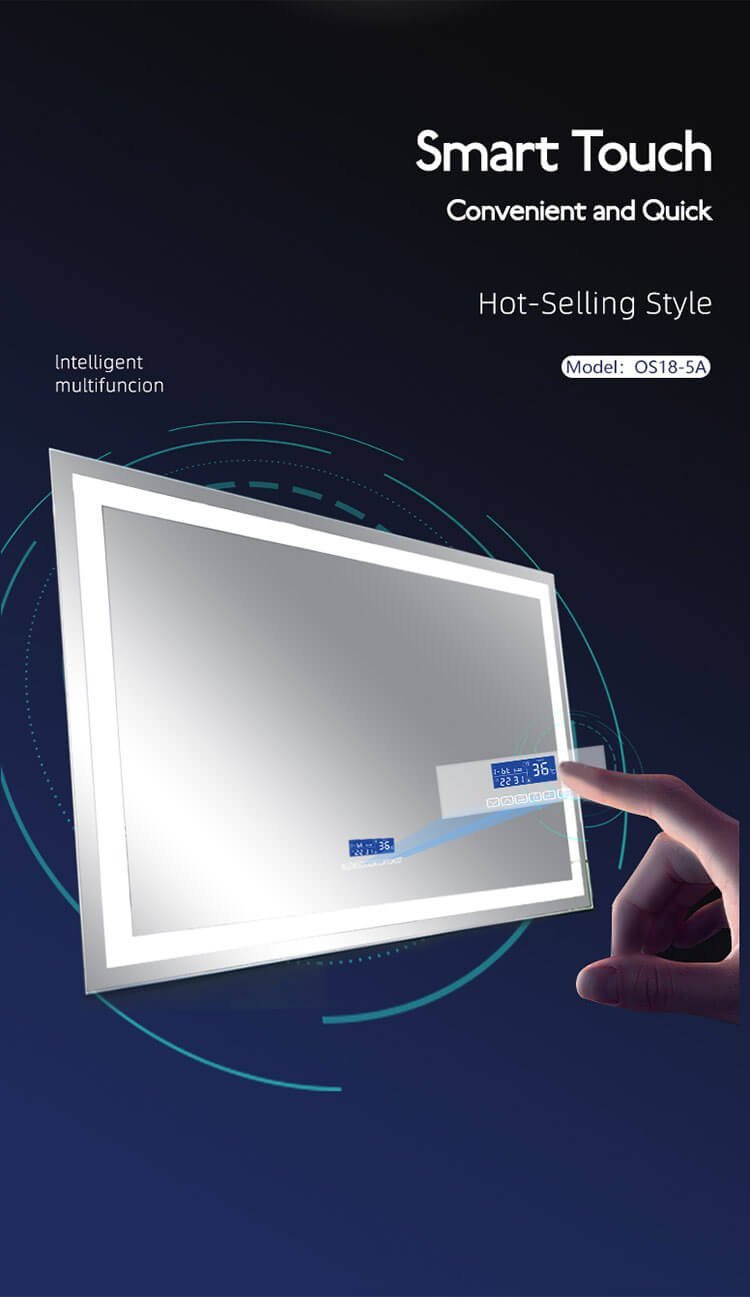هل تحتاج المرايا LED إلى الكهرباء? Without clear information, you might face unexpected electrical work, higher installation costs, or choose the wrong mirror type for your space. This comprehensive guide provides definitive answers about LED mirror power needs.
Yes, LED mirrors require electricity to power their integrated LED lights and control systems. These modern lighted mirrors connect to your home’s electrical supply through hardwired connections or plug-in adapters, consuming significantly less energy than traditional incandescent bathroom lighting while providing superior illumination.
Understanding the electrical requirements will help you make informed decisions about your bathroom renovation or vanity upgrade.
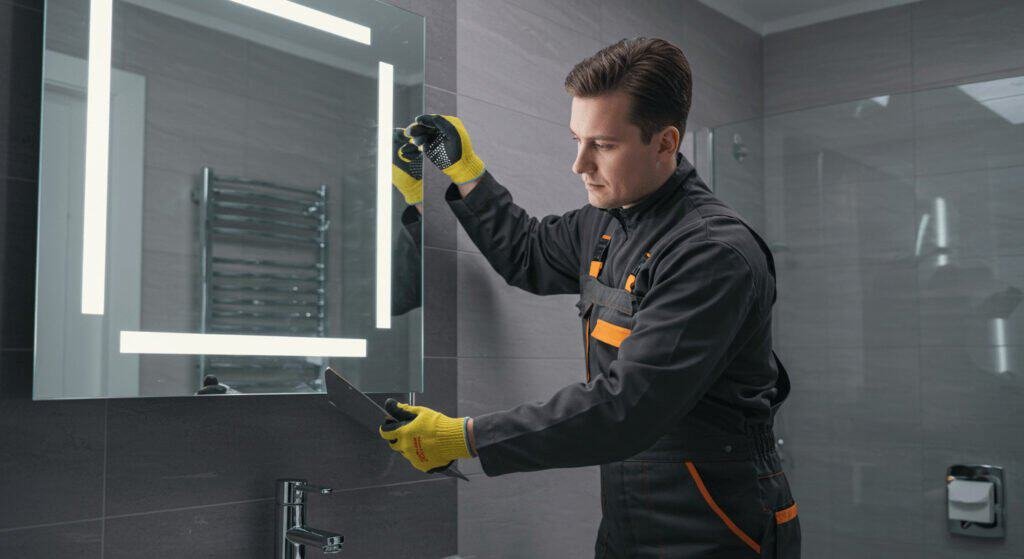
How Does LED Mirror Work?
LED mirrors combine reflective glass surfaces with integrated lighting technology to provide optimal illumination for grooming tasks. The system consists of LED light strips positioned around the mirror perimeter or behind the glass, creating even light distribution without shadows.
LED mirrors operate through a sophisticated electrical system that includes LED chips, driver circuits, and control mechanisms. The LED strips receive power from a transformer that converts standard household voltage to the lower voltage required by LED components.
The driver circuit regulates current flow to ensure consistent brightness and color temperature across all LED segments. Advanced models incorporate dimming capabilities, color temperature adjustment, and smart features like motion sensors or Bluetooth connectivity.
The electrical components are sealed and rated for bathroom environments, meeting safety standards for moisture exposure. Quality led bathroom mirrors from experienced manufacturers include proper electrical isolation and surge protection to ensure long-term reliability in humid conditions.
How Are LED Mirrors Powered?
LED mirrors receive power through two primary methods depending on their design and intended installation location. Most bathroom vanity mirrors require hardwired electrical connections integrated into your home’s electrical system for permanent installation.
Hardwired LED mirrors connect directly to household electrical circuits through junction boxes, typically requiring 110-120V AC power that gets converted to low-voltage DC for the LED components. This installation method provides reliable power supply and clean aesthetics without visible cords.
Some vanity mirror with led lights models offer plug-in options with wall adapters, though this approach is more common for portable or temporary installations. The plug-in method works well for lighted makeup mirror applications where flexibility is preferred over permanent mounting.
Professional bathroom mirror installations typically favor hardwired connections for several reasons: enhanced safety in wet environments, cleaner appearance without exposed cords, compliance with electrical codes, and integration with wall switches. Modern lighted mirrors for bathrooms often include additional features like defoggers or Bluetooth speakers that benefit from stable hardwired power connections.
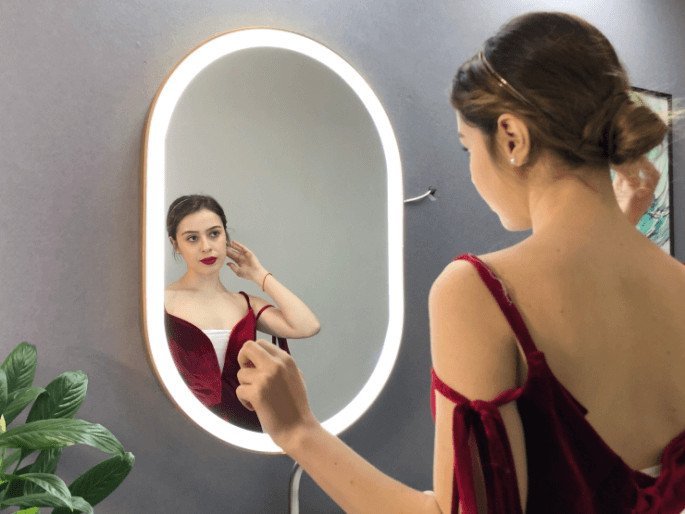
Are LED Mirrors Battery Operated?
Most standard LED bathroom mirrors are not battery operated due to power consumption requirements and the need for consistent, reliable illumination. Battery operation would require frequent replacements or recharging, making it impractical for permanent bathroom installations.
LED mirrors require continuous power supply to maintain their lighting functions, and batteries cannot efficiently support the power needs of full-size bathroom vanity mirrors for extended periods.
لكن, some specialized applications do utilize battery power. Small battery powered led mirror units designed for travel or temporary use can operate on rechargeable batteries for limited durations. These portable lighted vanity mirrors typically offer basic lighting without advanced features like dimming or color adjustment.
Battery operated mirror wall mounted options exist primarily for situations where electrical connections are unavailable or impractical. The trade-offs include limited operating time, reduced brightness compared to hardwired units, and the ongoing maintenance of battery replacement or charging. For permanent bathroom installations, battery powered led bathroom mirror options remain uncommon due to reliability concerns and user convenience factors.
Do LED Mirrors Need Wiring?
Yes, most LED mirrors require electrical wiring for proper installation and operation. Professional wiring ensures safe power delivery and compliance with electrical codes, particularly important in bathroom environments with moisture exposure concerns.
LED mirrors need hardwired electrical connections to provide stable power for their lighting systems and additional features. Standard installation requires running electrical cable from the circuit panel to the mirror location through proper junction boxes.
The wiring process involves several critical steps that typically require licensed electrical work. New installations need dedicated circuits or connections to existing bathroom lighting circuits, depending on the mirror’s power requirements and local electrical codes. Modern bathroom mirror installations must include proper grounding and GFCI protection for safety in wet locations.
The electrical rough-in work occurs during construction or renovation phases, positioning junction boxes at appropriate heights for the chosen lighted bathroom mirror. Wire gauge selection depends on the mirror’s power consumption and distance from the electrical panel. Most led vanity mirror installations use 12 or 14 AWG wire for adequate current capacity. Professional installation ensures proper wire connections, secure mounting, and compliance with National Electrical Code requirements for bathroom electrical work.

Do LED Mirrors Turn On With a Switch?
LED mirrors can be controlled through various switch mechanisms depending on their design and installation configuration. Most models offer multiple activation methods to accommodate different user preferences and bathroom layouts.
LED mirrors typically incorporate touch-sensitive controls directly on the mirror surface, allowing users to activate lighting, adjust brightness, and control additional features without separate wall switches.
Traditional wall switch control remains popular for lighted vanity mirrors for bathroom installations, providing familiar operation and integration with existing electrical systems. This method works well when the mirror connects to circuits controlled by standard light switches. Many modern led light mirror vanity units combine multiple control options.
Built-in touch controls handle brightness adjustment and feature selection, while wall switches provide main power control. Motion sensor activation offers hands-free operation, automatically turning on backlit mirror lighting when users approach. Smart home integration allows voice control and mobile app operation for advanced lighted vanity mirror models. The control method often depends on the specific bathroom mirror installation and user preferences. Some wall mirror with lights designs include both touch and switch capabilities for maximum flexibility.
| Control Method | Advantages | Best Applications |
|---|---|---|
| Touch Controls | Intuitive operation, adjustable settings | Modern bathroom mirror, vanity applications |
| Wall Switch | Familiar operation, easy installation | Traditional bathroom renovations |
| Motion Sensor | Hands-free convenience, energy savings | High-use bathrooms, accessibility needs |
| Smart Controls | Remote operation, integration capabilities | Tech-forward homes, luxury installations |
Are Lighted Mirrors Hardwired?
Most permanent lighted mirrors require hardwired electrical connections for optimal safety, performance, and aesthetic integration. Hardwiring provides the most reliable power delivery method for bathroom mirror installations.
Hardwired lighted vanity mirror installations connect directly to household electrical circuits through junction boxes, eliminating the need for visible power cords and providing stable electricity supply for all mirror functions.
Building codes in many jurisdictions require hardwired connections for permanently installed bathroom lighting fixtures, including modern bathroom mirror units with integrated illumination. This requirement ensures proper electrical safety in moisture-prone environments. The hardwiring process involves connecting the mirror’s electrical leads to house wiring through appropriate junction boxes and circuit protection. Licensed electricians typically handle this work to ensure code compliance and safety.
Hardwired light up vanity mirror installations offer several advantages over plug-in alternatives: enhanced safety through proper grounding and GFCI protection, cleaner aesthetics without visible cords, reliable power supply unaffected by unplugged connections, and integration with wall switch controls. Some rectangular bathroom mirrors and small bathroom mirror units designed for temporary or rental situations may offer plug-in options, but permanent installations benefit from hardwired connections.
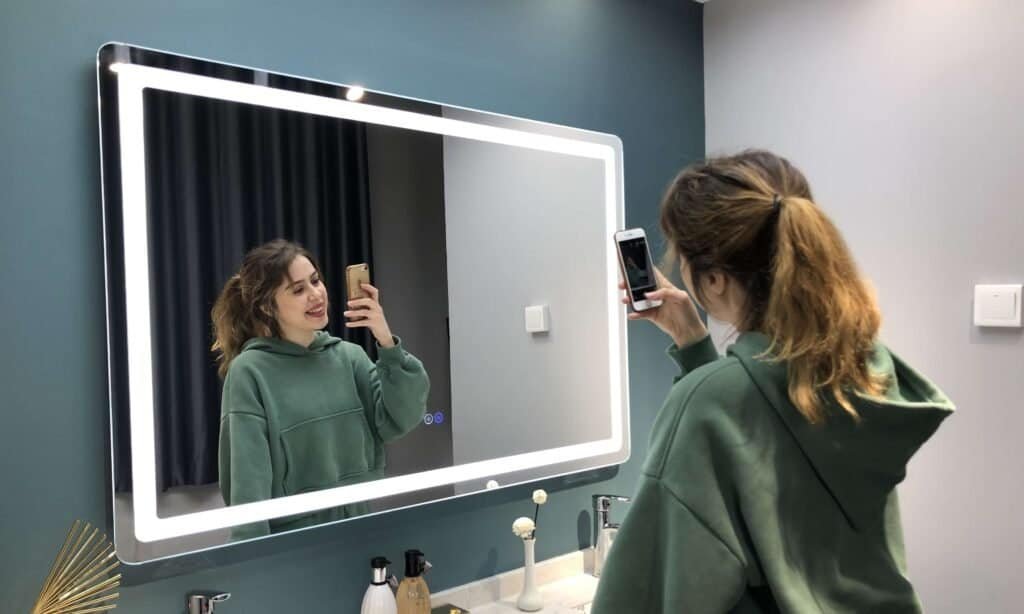
Do LED Mirrors Use a Lot of Electricity?
LED mirrors consume significantly less electricity compared to traditional incandescent bathroom lighting, making them energy-efficient choices for modern bathroom design. The actual power consumption varies based on mirror size and features but remains relatively low.
Typical led bathroom mirror units consume between 20-60 watts of power, considerably less than equivalent incandescent or halogen lighting systems that might use 100-300 watts for similar light output.
The energy efficiency of LED technology translates to substantial cost savings over the mirror’s lifespan. A standard lighted bathroom mirror operating for three hours daily costs approximately 15-45 dollars annually in electricity, depending on local utility rates and specific power consumption. Larger bathroom vanity mirrors with additional features like defoggers or Bluetooth speakers may consume slightly more power, typically ranging from 60-120 watts total.
لكن, the LED lighting portion remains the most efficient component. Advanced modern lighted mirrors for bathrooms often include automatic shutoff features and dimming capabilities that further reduce energy consumption. The long lifespan of LED components, typically 50,000 hours or more, means reduced replacement costs compared to traditional bulb-based lighting systems.
| نوع المرآة | Power Consumption | Annual Operating Cost* |
|---|---|---|
| Small lighted makeup mirror | 15-25 watts | $8-15 |
| Standard bathroom mirror | 30-45 watts | $18-28 |
| Large vanity mirror with led lights | 50-80 watts | $30-48 |
| Full-featured backlit mirror | 80-120 watts | $48-72 |
| *Based on 3 hours daily use at $0.12/kWh |
How Long Do LED Lighted Mirrors Last?
LED lighted mirrors typically last 15-20 years with normal residential use, significantly longer than traditional lighting solutions. The LED components themselves can operate for 50,000 ل 100,000 hours before requiring replacement.
Quality led mirrors from reputable manufacturers include LED chips rated for extended operation, with most components maintaining 80% or higher light output after 50,000 operating hours.
The longevity of modern lighted mirrors for bathrooms depends on several factors including build quality, operating environment, and usage patterns. High-quality mirrors with black frame designs and proper electrical components can exceed their rated lifespan in typical bathroom conditions. Environmental factors affecting lifespan include humidity exposure, temperature fluctuations, and electrical supply stability.
Proper ventilation and stable power supply contribute to extended mirror life. The electronic components like drivers and control circuits typically have shorter lifespans than LED chips, potentially requiring service after 10-15 years of operation. لكن, reputable manufacturers design these components for bathroom environments and provide appropriate warranties. Regular maintenance, including cleaning and ensuring proper ventilation, helps maximize the lifespan of bathroom vanity lights and integrated mirror systems.
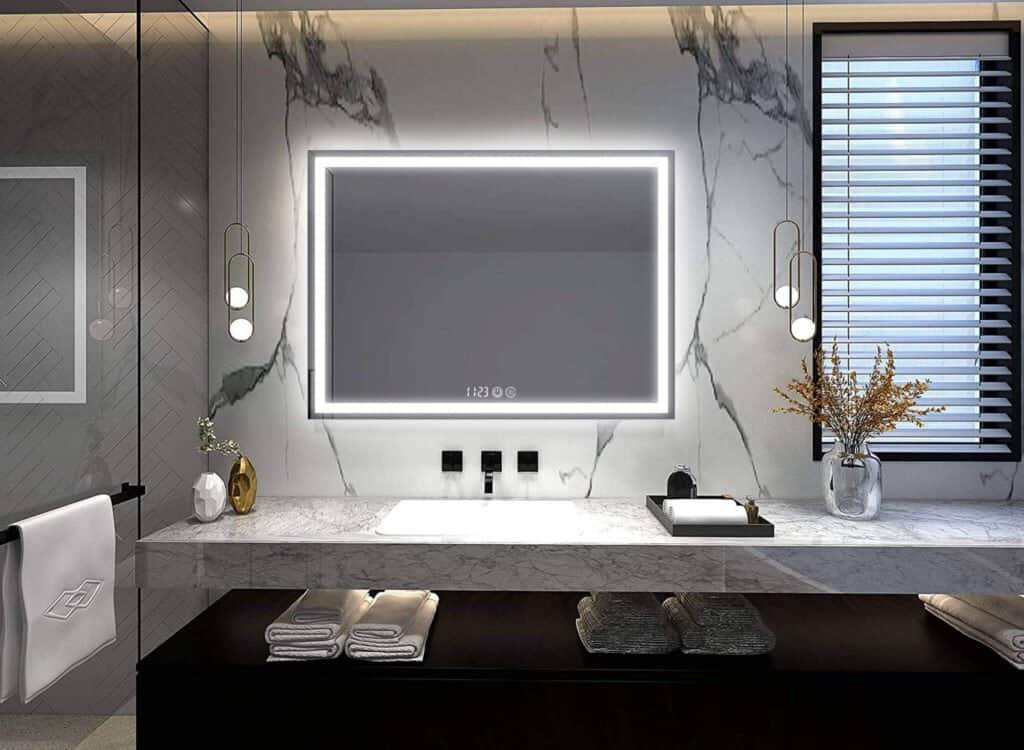
What Are the Disadvantages of LED Mirrors?
While LED mirrors offer numerous benefits, several disadvantages should be considered when evaluating pros and cons of lighted mirrors for your bathroom renovation project.
LED mirrors require higher initial investment compared to standard glass mirror alternatives, and installation complexity often necessitates professional electrical work, increasing total project costs.
The primary disadvantages include upfront cost considerations, as the best led bathroom mirrors command premium prices compared to basic reflective surfaces. Installation complexity represents another significant factor, particularly for hardwired units requiring electrical modifications to existing bathroom layouts.
Repair and maintenance challenges arise when electronic components fail, as LED drivers, control circuits, or individual LED segments may require professional service or complete unit replacement. Limited design flexibility can occur with integrated lighting systems, as the mirror’s electrical components dictate mounting methods and locations. Some users experience color temperature preferences that don’t match the mirror’s fixed or limited adjustment range.
Heat generation from LED components and electrical drivers, while minimal, can contribute to bathroom humidity in poorly ventilated spaces. Potential compatibility issues with existing bathroom electrical systems may require circuit upgrades or modifications for proper installation. Long-term repair costs and component availability become considerations as LED technology evolves and older models become obsolete.
خاتمة
LED mirrors definitively require electricity to power their integrated lighting systems and electronic features. While this creates installation considerations and ongoing energy costs, the benefits of improved lighting, energy efficiency, and extended lifespan make them valuable additions to modern bathroom designs.
- clik هنا ليعرف ما هي المرآة الخالية من النحاس?
- إذا لم تكن تعرف كيف اختر أيضًا ارتفاع الحمام الصحيح انقر هنا.
- تعرف على المزيد عن مشاكل مرآة الحمام LED
- clik هنا لمعرفة لماذا لا تعمل مرآة مستشعر اللمس
- clik هنا لمعرفة أحجام مرآة الغرور القياسية?
- clik هنا ليعرف لماذا المرايا باهظة الثمن?
- clik هنا ليعرف هل تحتاج المرايا LED إلى الكهرباء?
- clik هنا ليعرف هي مرآة مضاءة ما يكفي من الضوء للحمام?
- اكتشف 10 مشاكل مرآة الحمام المشتركة LED انقر هنا
For professional LED mirror installation and customization options, consult with experienced electrical contractors and reputable mirror manufacturers to ensure safe, compliant, and satisfactory results for your specific bathroom requirements.

